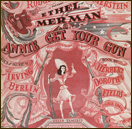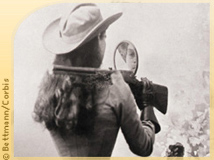
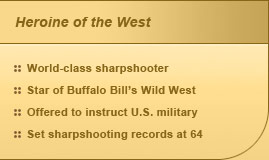
I don’t know how I acquired the skill, but I guess I was born with it.
—Annie Oakley, on her skill with a gun
An Ohio native, Annie Oakley wasn’t a Westerner by birth. But the “crack shot in petticoats” became an icon of the American West with her gutsy spirit, hard work and legendary skills with a gun. Only 5 feet tall and under 100 pounds, this modest Victorian lady shot a rifle better than any man around. Her sharpshooting skills and dazzling showmanship made her a worldwide star. But her gift as a markswoman also allowed her to survive an impoverished childhood. A self-made woman, Oakley always shot from the hip, refusing to use any deceptions in her stage shows or to compromise her values for fame—and she always hit the mark.
A Long Shot
Born Phoebe Ann Moses, Oakley was the fifth daughter of Quakers Susan and Jacob Moses. Her childhood in the Ohio wilderness was filled with great hardship due to the early death of her father, which left her mother a destitute widow with six children.
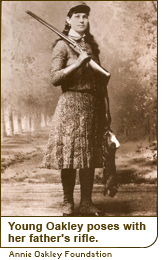 When Oakley was eight, she was sent to live at the Darke County Infirmary (the poor farm), where she received an education and learned to sew in exchange for her labor. Then she went to work for an abusive couple. She escaped after two years, and made her way back to the poor farm. Though treated kindly there, it wasn’t home. As the markswoman later explained, “I was homesick for the fairy places, the green moss, the big toadstools, the wild flowers, the bees, the rough grouse, the baby rabbits, the squirrels and the quail.”
When Oakley was eight, she was sent to live at the Darke County Infirmary (the poor farm), where she received an education and learned to sew in exchange for her labor. Then she went to work for an abusive couple. She escaped after two years, and made her way back to the poor farm. Though treated kindly there, it wasn’t home. As the markswoman later explained, “I was homesick for the fairy places, the green moss, the big toadstools, the wild flowers, the bees, the rough grouse, the baby rabbits, the squirrels and the quail.”
The wistful girl returned to her family in 1873, only to find her mother remarried and the family’s finances further diminished. So, Oakley picked up her father’s old Kentucky rifle and taught herself to hunt small game, both for the family to eat and to sell to a local grocer. She was a successful hunter and by age 15 had paid off her mother’s US$200 mortgage.
In 1881, Oakley entered a contest in a local park against renowned sharpshooter Frank E. Butler. She beat him by one shot. Smitten, Butler began to court Oakley and they married on August 23, 1876, when she was 16.
On May 1, 1882, Butler asked Oakley to fill in for his sick shooting partner in an exhibition. She held targets and displayed her own remarkable shooting skills. The young woman took her stage name, Oakley, from the park where she and Butler first met. A hit, Oakley became a regular part of her husband’s performance.
A Shooting Star
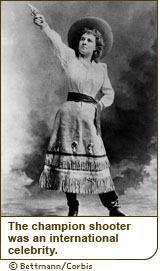 The couple’s big break came in 1885, when Captain Adam H. Bogardus, the champion shooter of Buffalo Bill's Wild West, retired. Oakley and Butler signed on to replace him, and, for the first time, Oakley was billed above Butler. He didn’t mind and happily assumed the role of her manager and assistant. Oakley quickly became the featured attraction, thrilling crowds with daring feats of marksmanship such as shooting ash off the end of a cigarette held in Butler’s mouth and hitting a dime tossed in midair at 90 feet.
The couple’s big break came in 1885, when Captain Adam H. Bogardus, the champion shooter of Buffalo Bill's Wild West, retired. Oakley and Butler signed on to replace him, and, for the first time, Oakley was billed above Butler. He didn’t mind and happily assumed the role of her manager and assistant. Oakley quickly became the featured attraction, thrilling crowds with daring feats of marksmanship such as shooting ash off the end of a cigarette held in Butler’s mouth and hitting a dime tossed in midair at 90 feet.
In 1887, Buffalo Bill’s Wild West toured Europe. There, the press went wild for the young woman sharpshooter. From French President Sadi Carnot, who offered her a token commission in the French army, to Queen Victoria, who broke tradition and left Buckingham Palace to watch her performance, Oakley became the darling of the royal heads of Europe. On the show’s second European tour in 1889, Oakley received star billing. In 1890, the performance returned stateside. For the next decade, Oakley was a featured performer, wowing audiences, setting records and winning medals along the way.
Derailed
A 1901 train wreck left Oakley partially paralyzed and forced the Butlers to leave the tour. She eventually recovered completely, returning to shooting exhibitions and starring in several plays.
Two years later, an erroneous news story accused Oakley of theft and cocaine addiction. Despite many retractions, Oakley spent the next six years suing every newspaper that ran the story. The article “nearly killed me,” she said. “The only thing that kept me alive was the desire to purge my character.” 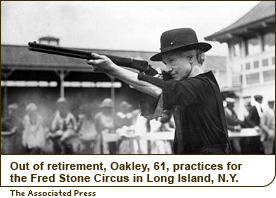 She settled or won 54 out of 55 lawsuits.
She settled or won 54 out of 55 lawsuits.
In 1913, the Butlers retired to Cambridge, Massachusetts. The quiet life didn’t last long. Bored with retirement, Oakley offered the U.S. military her skills as an instructor when World War I broke out. She then planned a comeback eight years later, at the age of 62. Her comeback was delayed after she and Butler were severely injured in an auto accident, but by 1924 Oakley was again setting sharpshooting records. It was a short-lived return; within a year, her health began to fail.
On November 3, 1926, Oakley died. Butler passed away ten days later. For many years, the cause of Oakley’s death was given as pernicious anemia. But a recent article in A&E Biography magazine suggests that it may “have been the long-term effects of lead poisoning from handling so much live ammunition over such a long career.”
:: Lisa Cooke
Annie Oakley Selected Sources





